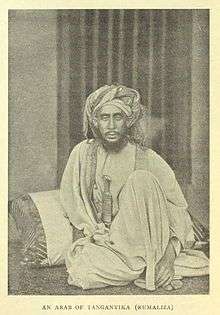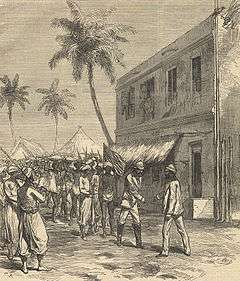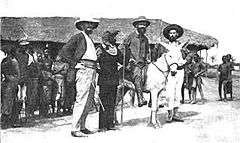Rumaliza
| Rumaliza | |
|---|---|
 Rumaliza, January 1900. | |
| Born |
Muhammad bin Khalfan bin Khamis al-Barwani c. 1855 Lindi, Tanganyika |
| Died | After 1894 |
| Nationality | Swahili |
| Occupation | Sultan of Ujiji |
| Known for | Slave and ivory trading |
Muhammad bin Khalfan bin Khamis al-Barwani (born c. 1855), commonly known as Rumaliza, was a Swahili[lower-alpha 1] slave and ivory trader in East Africa in the last part of the nineteenth century. With the help of Tippu Tip he became Sultan of Ujiji. At one time he dominated the trade of Tanganyika, before being defeated by Belgian forces under Baron Francis Dhanis in January 1894.
Background
The trade in slaves from East Africa dates back thousands of years. Arabs are documented as trading in slaves from the East African coast in the second century A.D.[1] The Arabs established a series of trading posts along the coast. Through prolonged contact with the Arabs, a distinctive Swahili ("coastal") culture developed among the Bantu people of the region.[2] Although the Swahili language has Bantu roots, it includes many words of Arabic origin.[3] For many years, Zanzibar was considered part of the kingdom of Oman.[4] The Swahili and Arab traders obtained slaves in the interior of East Africa and sold them in the great markets like Zanzibar on the coast. The trade peaked in the nineteenth century in response to growing local and international demand.[3]
Trader
Rumaliza was born at Lindi around 1855, on the Indian Ocean coast in the south of modern Tanzania. He was educated at Zanzibar during the reign of Majid bin Sa'id (1856–70).[5] He became a leader in the Qadiriyya Muslim brotherhood.[6] The Arab trader Tippu Tip from Zanzibar reached the Luba region in the late 1850s, trading in slaves, ivory and copper. Relying on force as needed to defeat uncooperative local chieftains, he steadily expanded his trading empire. In 1875 he established his capital as Kasongo.[7] Rumaliza spent some time with Tippu Tip at Tabora in western Tanganyika, and is said to have acquired his name from the nearby village or suburb called Rumaliza or Lumaliza.[8] Rumaliza formed a trading alliance with Tippu Tip.

A market where salt could be exchanged for other goods was established at Ujiji on Lake Tanganyika in Burundi in 1840. Tippu Tip and Ruwaliza established themselves there in 1881.[9] From 1883 Rumaliza was the leader of the Swahili community at Ujiji.[6] Rumaliza and his Magwangwara auxiliaries occupied five posts on the northeast coast of Lake Tanganyika between 1884 and 1894. He launched a series of raids into the mountains and up the Rusizi River valley as far as Lake Kivu.[10]
The HM Company, a trading organization led by Tippu Tip, appeared in 1883. It was backed by Sultan Bargash and Taria Topan. The International African Association offered their support if Tippu Tip would help them achieve control of the territories in which he had established strong points.[11] Tippu used trade goods advanced to the company to form an alliance with Rumaliza, who had many men but was short of money and could not obtain loans. The new company operated between Ujiji and Stanley Falls and in areas to the south of this line, controlled by Abdullah ibn Suleiman as lieutenant of Tippu Tip and Rumaliza.[6] Between 1885 and 1892, after the death of Mwenge Heri, Rumaliza consolidated his power over the Masanze, Ubvari, Umona and Ubembi people. He wanted to open new trade routes towards Maniema to the west and Ituri to the north.[12]
In 1886 Tippu Tip recognized the Congo Free State and was made Governor of the eastern areas that were covered by his trading network. In 1890 Rumaliza provided large amounts of ivory to the African Lakes Company for transport.[6] Taria Topan died in late 1891. Tippu Tip obtained part of the estate as payment for outstanding debts. Rumaliza sued for a share in the Dar es Salaam court as a newly-loyal German subject. He was awarded some of Tippu's property in German East Africa.[13]
White Fathers

The White Fathers missionaries had established posts in the northwest of Tanganyika that formed an obstacle to Arab incursions into the Maniema region, protected by Captain Léopold Louis Joubert, a former Papal Zouave.[14] Rumaliza tolerated the foundation of the missions at Mulwewa in 1880 and Kibanga in 1883, but would not allow establishment of a station at Ujiji.[12] In May 1890 a group of Arabs came close to attacking the White Fathers mission at Mpala on the west shore of Lake Tanganyika, and only withdrew after a storm destroyed a number of their supply boats. Before leaving they confirmed that Rumaliza had given orders to them not to harm the missionaries.[15] In September 1890 the White Fathers missionaries Léonce Bridoux and Francois Coulbois visited Ujiji, where they found Rumaliza and Tippu Tip. The two slavers were friendly, and Rumaliza was anxious that the missionaries gave a good report of him to Emin Pasha, who was expected at Ujiji. Rumaliza apologized for the hostility his men had shown to the missionaries, saying he was unable to control them.[15]
However, Rumaliza was determined to eliminate Léopold Louis Joubert, commander of the forces defending the White Fathers, who was disrupting the slave trade.[16] By 1891 the slavers had control of the entire western shore of the lake apart from Mpala and the Mrumbi plain.[17] Joubert's position was ambiguous. The Belgians had appointed Tippu Tip as their lieutenant in the region, but Joubert refused to recognize the authority of the slaver.[18] During a lull in January 1891, Father I. Moinet visited Ujiji. There he found Rumaliza flying a German flag and saying he was waiting for the Germans to arrive so he could hand over to them. In a letter to Joubert in April 1891, Rumaliza asked if he was employed by the missionaries or by the government of the Congo. Joubert was evasive in his reply, pointing out that Rumaliza sometimes flew the German flag, sometimes the flag of Zanzibar and sometimes that of Britain.[19]
Defeat

The Congo Free State became stronger and less tolerant of "Arab" strongmen, determined to stamp them out.[13] By 1892 Rumaliza dominated Tanganyika from his base at Ujiji on the old slave route that led from Stanley Falls up the Lualaba River to Nyangwe, east to Lake Tanganyika and then via Tabora to Bagamoyo opposite Zanzibar. The total number of Swahili fighters in this huge region numbered around one hundred thousand, but each chief acted independently. Although experienced in warfare, they were poorly armed with simple rifles. The Belgians had just six hundred troops divided between the camps at Basoko and Lusambo, but were much better armed and had six cannons and a machine gun.[20] A Belgian expedition under Captain Jacques came to the relief of Joubert in 1892, and then established a position at Albertville, where Rumaliza's troops were defeated by a relief column while besieging the post.[14]
The Belgian forces under Francis Dhanis launched a campaign against the slave dealers in 1892, and Rumaliza was one of the main targets.[21] Dhanis advanced up the river. He reached Nyangwe on 4 March 1893 and Kasongo on 22 April 1893, finding both towns abandoned. He found a huge supply store at Kasongo including ivory, ammunition, food and luxuries such as gold and crystal tableware. For the next six months Dhanis remained inactive, while Rumaliza's forces were swelled by Swahili fighters who had escaped after defeat by Dhanis.[22]
In 1893 Tippu Tip advised Rumaliza to retire from the trade, but Rumaliza first had to look after his people at Lake Tanganyika.[13] Rumaliza raised a strong force, which clashed with Dhanis' column on 15 October 1893 causing the death of two European leaders and fifty of their soldiers. On 19 October 1893 Rumaliza attacked a position one day's march from Kasongo.[23] Dhanis concentrated his forces and defeated Rumaliza. A column under Lothaire pursued him to the north of Lake Tanganyika, destroying his fortified positions along the route. At the lake they joined with the anti-slavery expedition led by Captain Alphonse Jacques.[14]
By 24 December 1893 Dhanis had obtained reinforcements and was ready to advance again. Rumaliza had also received assistance. Dhanis sent one column under Gillain to prevent Rumaliza from retreating, and another under De Wouters to advance on Rumaliza's fort near Bena Kalunga. A group of fresh forces coming to Rumaliza's aid from Tanganyika was headed off, and Dhanis's forces closed in on Rumaliza's two bomas.[24] On 9 January 1894 Belgian reinforcements arrived under Captain Lothaire, and the same day a shell blew up Rumaliza's ammunition store and burned down the fort containing it. Most of the occupants were killed while attempting to escape. Within three days the other forts, cut off from water supplies, surrendered. More than two thousand prisoners were taken, although Rumaliza himself managed to escape.[25] Rumaliza took refuge in the German territory of Tanganyika.[22]
References
Notes
- ↑ Contemporary European sources often refer to Rumaliza and other Swahili slavers as Arabs. Certainly they were Muslim and had absorbed much of the Arab culture.
Citations
- ↑ Wink 2002, p. 30.
- ↑ Wink 2002, p. 28.
- 1 2 Insoll 1997, p. 523.
- ↑ Wink 2002, p. 29.
- ↑ Martin 2003, p. 169.
- 1 2 3 4 Oliver 1985, p. 563.
- ↑ Simba 1997, p. 138.
- ↑ Martin 2003, p. 170.
- ↑ Chrétien 1993, p. 172.
- ↑ Chrétien 1993, p. 134.
- ↑ Oliver 1985, p. 562.
- 1 2 Rumaliza 1975, p. 620.
- 1 2 3 Oliver 1985, p. 569.
- 1 2 3 Ergo 2005, p. 43.
- 1 2 Swann & Bennett 2012, p. 31.
- ↑ Coosemans 1951, p. 518.
- ↑ Shorter 2003.
- ↑ Swann & Bennett 2012, p. 32.
- ↑ Swann & Bennett 2012, p. 33.
- ↑ Ndaywel è Nziem, Obenga & Salmon 1998, p. 296.
- ↑ Ergo 2005, p. 41.
- 1 2 Ndaywel è Nziem, Obenga & Salmon 1998, p. 297.
- ↑ Ergo 2005, p. 42.
- ↑ Boulger 1898, p. 179.
- ↑ Boulger 1898, p. 180.
Sources
- Boulger, Demetrius Charles (1898). The Congo State: Or, the Growth of Civilisation in Central Africa. Cambridge University Press. p. 179. ISBN 978-1-108-05069-2. Retrieved 2013-04-13.
- Chrétien, Jean-Pierre (1993). Burundi, l'histoire retrouvée: 25 ans de métier d'historien en Afrique. KARTHALA Editions. p. 134. ISBN 978-2-86537-449-6. Retrieved 2013-04-13.
- Coosemans, M. (1951). "Biographie Coloniale Belge" (in French). Inst. roy. colon. belge. Retrieved 2013-04-11.
|chapter=ignored (help) - Ergo, André-Bernard (2005). Des bâtisseurs aux contempteurs du Congo Belge: L'odyssée coloniale. Editions L'Harmattan. ISBN 978-2-7475-8502-6. Retrieved 2013-04-12.
- Insoll, Timothy (1997). "Swahili". The Historical Encyclopedia of World Slavery: A-K ; Vol. II, L-Z. ABC-CLIO. p. 623. ISBN 978-0-87436-885-7. Retrieved 2013-04-13.
- Martin, B. G. (2003-02-13). Muslim Brotherhoods in Nineteenth-Century Africa. Cambridge University Press. ISBN 978-0-521-53451-2. Retrieved 2013-04-13.
- Ndaywel è Nziem, Isidore; Obenga, Théophile; Salmon, Pierre (1998). Histoire générale du Congo: De l'héritage ancien à la République Démocratique. De Boeck Supérieur. p. 296. ISBN 978-2-8011-1174-1. Retrieved 2013-04-13.
- Oliver, Roland Anthony (1985). The Cambridge History of Africa. Volume 6: From 1870 to 1905. Cambridge University Press. p. 562. ISBN 978-0-521-22803-9. Retrieved 2013-04-12.
- "Rumaliza". Hommes et destins: dictionnaire biographique d'outre-mer. Académie des sciences d'outre-mer. 1975. ISBN 978-2-900098-03-5. Retrieved 2013-04-14.
- Shorter, Aylward (2003). "Joubert, Leopold Louis". Dictionary of African Christian Biography. Retrieved 2013-04-10.
- Simba, Malik (1997). "Central Africa". The Historical Encyclopedia of World Slavery: A-K ; Vol. II, L-Z. ABC-CLIO. p. 138. ISBN 978-0-87436-885-7. Retrieved 2013-04-13.
- Swann, Alfred J.; Bennett, Norman (2012). Fighting the Slave Hunters in Central Africa: A Record of Twenty-Six Years of Travel and Adventure Round the Great Lakes. Routledge. p. 31. ISBN 978-1-136-25681-3. Retrieved 2013-04-12.
- Wink, Andre (2002). Al-Hind, the Making of the Indo-Islamic World: Early Medieval India and the Expansion of Islam 7Th-11th Centuries. BRILL. ISBN 978-0-391-04173-8. Retrieved 2013-04-13.